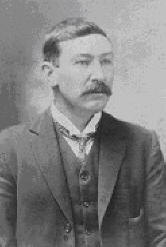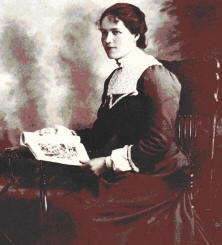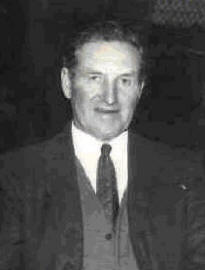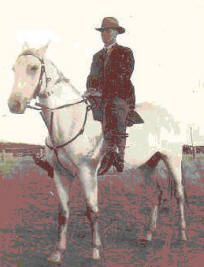
Home | Pioneers | Contact Us | Copyright/Disclaimer
Robert John Williams
"Glenbog", Nimmitabel
John Williams Snr | John Williams Jnr | David Williams |
Robert Williams | Edward Williams
William Williams | George Williams |
Carol Baxter's Site
Robert John Williams (1871 - 1955)
and his wife Sarah Williams nee Hayden (1875 – 1955)
1. John James (Jack) Williams
2. ALEXANDER (ALEC) ROBERT WILLIAMS
3. HERBERT JOFFRE (JOFF) WILLIAMS
 |
 |
Robert John Williams
|
Sarah Williams (Hayden)
|
The descendents of Robert John Williams and Sarah Hayden are the only branch of the family to have lived continuously in the Nimmitabel district to the present day.
Robert John Williams, the fifth child of George and Jessie, was born when the family was living at Springfield on 15 August 1871. In 1884 the family moved to Glenbog, where Robert lived for the rest of his life, with the exception of his closing years when he lived in Nimmitabel.
In 1906 he married Sarah Williams Hayden (27 July 1875), the daughter of James Hayden and Elisabeth Hyland of Stockyard Flat, near Delegate. They initially lived on a portion of Glenbog called “Little Bog”, which is on the current Snowy Mountains Hwy at the head of the Bombala River.
Their three children were born while they were living on this block
1. John James (Jack) on 22 July 1907
2. Alexander Robert (Alec) on 5 May 1911
3. Herbert Joffre (Joff) on 8 October 1914
Around 1930 Robert (nick-named “Big Bob”) bought “Stonehenge” from another Robert Williams (“Little Bob”) and extended the Stonehenge homestead by knocking down the Little Bog house and adding it to the Stonehenge house. Robert and Sarah grazed sheep and cattle, and ran a dairy at Stonehenge until the late 1940s.
They rented at various times during the 1920s a house in Nimmitabel (opposite Bernie and Val Buckley) and the old stone house on Hayfield (beyond the Showground) so that Alec and Joff could go to school in Nimmitabel. Jack had earlier attended a couple of years at the Glenbog School at Steeple Flat.
In their later years, Robert and Sarah moved into Nimmitabel and lived with
Alec and his wife Eileen in their house in Boyd St until their deaths. They both died in 1955; Sarah on her 80th birthday on 27 July and Robert on 25 September, three days after the birth of his first grand-daughter, Elizabeth.
Submitted by David Williams <glenbog-at-cyberone.com.au>
1. John James (Jack) Williams 22.7.1907 – 2.3.2004
 |
 |
Many will remember Jack as committed to the advancement of the Nimmitabel community. With support from his wife Jean Catherine Madden whom he married in Bemboka on the 2nd of February 1938, Jack worked tirelessly for many years to improve services available to families in Nimmitabel. Jack and Jean lived for many years at “Girraween” Steeple Flat, Nimmitabel
Jack's wife Jean died in 1976 but she will be fondly remembered as a warm caring person with a vibrant personality, a great sense of humour and the ability to get along with everyone. She was also an excellent cook, being successful in all district shows.
Jack was active at committee level in a variety of local institutions. His
achievements were:
The Nimmitabel Hall committee for 48 years and President for 20 years. He and Jean were very active in raising finances to build the current hall, called the Pioneers Memorial Hall.
The Nimmitabel Show Committee for 45 years, 15 years as President
President of the Bush Nursing Association for as long as many can remember.
He was a member of the local Bush Fire Brigade for 50 years and served as Captain, and Vice Captain for long periods during this time. He was awarded a National Fire Brigade Medal for this service.
Jack was involved in organizing a rodeo in Sydney during the war years. It was there that he first experienced Campdrafting and brought it back to the local region. He remained active in Campdrafting in this area for many years and saw it flourish as a sport. He won an Open Campdraft in Bega in the mid 1970’s at the age of 69 years. For his contribution he was made a life member of the Southern Districts Campdrafting Association.
He was an astute breeder of good horses, and several of these were used in the 1956 Olympic Games, as overseas competitors were not allowed to bring their own horses into Australia due to quarantine restrictions.
Jack was always dedicated to the preservation of a strong family unit. He showed this commitment first to his two brothers Alec and Joff. He and Joff were not only farming partners but were loyal and dedicated to each other’s welfare. It was from recognition of the work within the community done by the William’s families that the Lake which was created in Nimmitabel in 1994 was named Lake Williams.
Many of you will remember Jack as a man who loved to hear a story and recount his own experiences. He had a great ability to recall significant and humorous events in the near and distant past. In his later years Jack developed a reputation for factual recall of local history and enjoyed sharing this knowledge. Jack had a keen sense of humor; once while being quizzed at the local show about his ability to control a bolting horse Jack was heard to reply that he was always able to ride faster than the horse could bolt. Jack was always optimistic about the future – at the age of 85 years he considered buying a new saddle. When seen testing the stirrup leathers, Jack was quizzed by the young sales assistant as to what he was doing. He replied that he was just testing them to see if they would last. He rode regularly until he was 88 years of age.
Jack, with his brother Joff drove stock many miles during the years as drovers. On one occasion they drove 700 head of jersey heifers from Bega to Corryong over the Snowy Mountains. They arrived at their destination without losing a beast. Jack also told the story of having been camped on a high embankment at the foot of the Brown Mountain, when a car pulled up just below them on dark with 2 people in it. One said to the other,” I wonder how far it is to Bega?”. Joff said from on high “It’s 22 miles”. These two men and the car couldn’t be seen for dust as they fled from that ghostly voice from above.
Jack made it quite clear that he would never fly anywhere in an aeroplane. He said that sitting on a horse was the highest he wished to be above the ground. In spite of the fact that he remained in this area for his 96 years he was very global in his attitudes. He was always regarded as very accepting, tolerant and non-judgmental and had a genuine desire to appreciate cultural diversity.
All are familiar with Jack’s reputation as a horseman, successful grazier, family man and community worker for this town but to those who knew him Jack was so much more than this. Jack was a deeply spiritual man and this gave him both great strength and comfort. His unflinching belief in prayer supported him through the years, especially the lonely times after Jean died. To witness Jack quietly saying the rosary illustrated his deep faith and spirituality that was fundamental to who Jack Williams really was.
|
Rear l to r: Jim and Tony.
|
Jack was predeceased by his wife Jean who died in 1976, and his son Tony who died in 2003. Jack’s and Jean’s children are Anthony (Tony) born 7 May 1939, James (Jim) born 15 September 1940, Edward (Ted) born 24 July 1943, Philip (Phil) born 6 January 1945 and John born 15 October 1947.
From John Williams 22.05.06
2. ALEXANDER (ALEC) ROBERT WILLIAMS (5.5.1911 – 28.6.90)
|
Alec & Eileen wedding party
|
There was no gentler man than Alec to be found on the Monaro. He was a man who held the highest values and lived them every day. “If you can’t find something good to say about someone, then don’t say anything”, he’d say. Here was a man who didn’t even minimize his tax.
Born to Robert and Sarah Williams (nee Hayden) on 5 May 1911 at the ‘Little Bog’ about 15 kilometers east of Nimmitabel – sadly only the poplars and the pine tree remain next to the highway to pin point the location - Alec with elder brother Jack and younger brother Joffrey helped their parents farm the land and raise cattle and sheep.
It was a fairly Spartan existence at the Little Bog, typified by the boys having to ride horses bareback on a bush track to the Glenbog school in the area at Steeple Flat, some 5 kilometers away. They did the normal things to help around the farm, like set poison baits for foxes and then have to follow their father back to the homestead with both hands firmly planted in their pockets in case they were tempted to put their strychnine covered hands near their mouths. Their father could be strict at times.
With the ‘Great Depression’ looming, Alec left the land and joined the Post Master General (now Australia Post) in 1925 at age 14. Fifty one years later, Alec was still giving diligent, faithful service to Queen and country in the same job and he retired in 1976. Alec’s career allowed him to experience life in other parts of the country, especially on the Far South Coast in towns like Moruya, Tathra, and Eden, and on the Southern Tablelands in Bombala, Nimmitabel, Cooma, Canberra (relieving) and Captain’s Flat. He served in Nimmitabel from 1925 to 1929 and 1945 to 1976. Alec also served the community in which he lived and at Nimmitabel was involved in many clubs and societies especially the Lions Club and the Country Club.
Alec cut a pretty little filly out of the Britten mob. Audrey Eileen (known as Eileen) lived with her parents David and Penelope Britten at Garfield, about 15 kilometres west of Bega, on a property called ‘Summerhill’. Eileen, with her brothers Alan and Raymond, and sisters Doris, Joan, and Sylvia helped run the family dairy farm in the Bega Valley. Having met at a dance in Nimmitabel, Eileen, already betrothed to another, couldn’t resist Alec’s charm and the two were later married in Bombala on 25 May 1940.
Wanting to be inclusive, Alec and Eileen named their first born David Alexander Robert (known as Robert). He was born in Bombala on 24 March 1944. Eileen’s marriage was to later cause some complications at home as the Brittens were of the Protestant religion, and to marry someone of the Catholic faith and convert at the same time was beyond comprehension. It took Eileen some time to admit to her father that she had converted and neither Eileen nor her new family darkened the Britten family’s door step for a number of years after that. Such was the culture of the time.
Serendipitously, Peter Raymond was born on 8 July 1955, born in Cooma hospital, while Alec and Eileen were living at Nimmitabel.
Alec’s brothers worked the land on a full-time basis near the summit of the Brown Mountain about 16 kilometers east of Nimmitabel. Jack and his family lived at ‘Giraween’ at Steeple Flat and Joff and his family living a few kilometers away at ‘Stonehenge’. Although Alec lived in the township and worked full-time in the post office, he held smaller portions of land close to town and raised beef and sheep. Though Alec didn’t hold the legendry status as bush horseman that his brothers did, he was no slouch on the back of a horse. In fact, he felt more comfortable with one horsepower under him than he did with many. He was notorious as the “back seat driver from you know where” if the car he was travelling in reached anywhere near the speed limit. Alec also had a good eye for a fine horse and for good cattle as well.
The three families would congregate on Sunday mornings after mass in town at Eileen’s café and discuss important events like how much rain had fallen and how many cows had calved that week. Eileen bought the café from Mrs Tozer in the mid 60s and made it a very successful business. Most of the truckies who carried timber, logs or livestock throughout the region stopped at ‘Williams Café’ and enjoyed a good meal and a friendly chat. She was an outstanding cook and won prizes at the local shows for her scones, biscuits and sponges. Her Christmas cake recipe is the best and is still used today. Eileen died on 15 January1976, aged 62 from kidney disease, and the café was then sold.
Robert was educated at Inverolochy agricultural boarding school and held similar interests to his father and uncles: the land, raising sheep and cattle, breeding and racing thoroughbred horses, and having the occasional wager. Robert was a qualified wool classer and chased the sheds classing wool for a living. He also had small holdings of land and ran sheep and cattle. Robert never married.
Peter, however, made up for the shortfall and married twice. After attained his secondary education in Cooma, he left the region in 1974 to follow a career in policing in Canberra. He married Karin Dawes, a Cooma girl, and they had Melissa Jane (27.10.77) and Shannon Louise (18.12.79). His second marriage was to a Wollongong girl who also worked in the Federal Police: Lisa Howard (nee Sakun). Sarah Eileen was born on 14 September 1997, and Benjamin Alexander on 22 September 1999.
Alec missed his little filly terribly and life following her death seemed to lack meaning and purpose. He once said that marriage was a bit like a lucky dip and that he had been pretty lucky with his. His health slowly deteriorated and he died from heart disease on 28 June 1990 aged 79 years.
Robert contracted diabetes in later life, which compromised his health markedly. He died at age 60 on 6 January 2004 in Canberra.
From Peter Williams, submitted by David Williams <glenbog-at-cyberone.com.au> 22.05.06
3. HERBERT JOFFRE (JOFF) WILLIAMS
(9.10.1914 – 6.08.1989)
|
|
Joff was born at Little Bog (at the head of the Bombala River) on 8 October 1914 - a 12 lb. baby who grew up to be known as the ‘gentle giant’.
The family, while farming at Glenbog, also rented at various times a house in Nimmitabel and at “Hayfield” so that Joff and Alec could attend school in Nimmitabel. His eldest brother Jack attended the Glenbog School at Steeple Flat. There were many tales told of walking to St Joseph’s Convent in short pants from Hayfield in winter, and of the antics he got up to going to and from school.
Joff was a brilliant student, winning several diocesan awards for academic achievement. He also won three Jardine Medals (the precursor to the Jardine Cup) during his primary schooling at St Joseph’s Convent. He placed a great deal of importance on education and in later years involved himself in his own children’s schooling, and was to make many sacrifices to ensure his children received the best education possible.
Joff attended St Patrick’s College in Goulburn for one year in 1929 and then, because of financial pressures inflicted by the Depression, spent a year in Melbourne with his uncle Edward Williams attending Williamstown Boys High School in 1930. He showed a special aptitude for figures, and would have liked to pursue this further. However, limited opportunities during the Depression, and strong ties to his family and the land kept him at Stonehenge. One wonders what he may have achieved in life had he been given the opportunity to enter the world of business and commerce.
On leaving school, Joff worked his parent’s small holding, supplementing this with rabbiting and droving cattle with his brother Jack from the Monaro down to the coast and Victoria, and could tell many stories about these days. He slept with his head in the saddle, often choosing to sleep out under the stars rather than opt for the flea invested drover’s huts. He told many tales of droving with Alf Ireland, who would “take a pound note and a clean shirt, and never change either of them”.
He cared for aged parents at Stonehenge, and continued this caring relationship with regular visits to them after they had moved into Nimmitabel in their final years with his brother Alec, and wife, Eileen.
Joff inherited his strong faith in the Catholic religion from his mother, and was a stalwart of St Andrew’s Church, Nimmitabel all his life, from the time when, as a boy, he drove his mother by buggy from Little Bog to Nimmitabel every Sunday for mass, to his death in 1989.
Joff, for many years farmed his own land and farmed some in partnership with his brother Jack, with whom he had a particularly close relationship. After the partnership was dissolved, Joff also bought a parcel of land at Bobingah (ironically, part of the original ‘Head of Curry Flat’ run). He grazed sheep and cattle, and held a wool classer’s certificate. The Hereford cattle, which were his pride and joy, were also agisted for many years on several Crown leases in the Brown Mountain. Many long days were spent in the saddle when mustering this country. He was also a regular prize winner for fat lambs at the Nimmitabel Show.
The topography of Glenbog and the leases in the Brown Mountain ensured that horses continue to this day to be the only means of mustering this country. Joff was an extremely capable horseman, and had a keen appreciation for thoroughbred horses.
Joff had a love of reading and history, and had a prodigious memory for people, places and events. In about 1987, for example, he was shown a photo of St Joseph’s Convent pupils taken in 1925, and was able to remember every name except four, and who most of them married. This gift for telling stories from days gone by, shared with his brother Jack, who was a great raconteur and story-teller, over morning tea at Stonehenge, continually amazed family and visitors. People from all walks of life and all ages returned each year to ‘Stonehenge’ to enjoy his and Monie’s hospitality, never ceasing to tire of his stories of local personalities of years gone by.
Joff had a keen sense of humour and enjoyed a good joke, music and dancing.
An abiding memory of Joff for many in the Nimmitabel district will be the contribution he made to the Nimmitabel community and the town itself:
Joff met his wife-to-be, Monica (Monie) Elizabeth Bateman (born at ‘Lilymount’ Bemboka on 30 January 1924) when she was governess to Jim Jardine and his sisters Patricia and Helen at Curry Flat when Monie was eighteen years old.
After nursing training at the Mater Hospital in Sydney and Newcastle, and at several hospitals in Hobart, Monica returned home to nurse in Bega and resumed her association with Joff.
They married on the 31st January 1953 in Bemboka. Frank Ireland was Joff’s best man.
They had six childen:
Most of the years the children were at school were characterised by bad seasons caused by drought or poor commodity prices, or both. Joff and Monnie battled to give their children a good education, firstly at St Joseph’s Convent Nimmitabel, then sending the boys to St Patrick’s College and the girls to St Joseph’s College in Goulburn for secondary schooling.
Joff and Monnie were proud of what their children achieved in their family and working lives.
Unfortunately Joff was not to live long enough to enjoy all his grandchildren. He died on 6 August 1989 in his 74th year.
One of nature’s gentlemen who never raised his hand or his voice to anyone.
Submitted by David Williams <glenbog-at-cyberone.com.au> 22.05.06
|